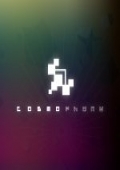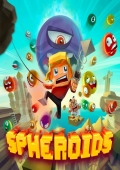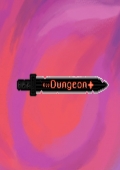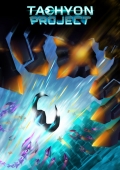Cosmophony review
When good Dubstep goes bad...
It's been far too long since I've written a review for this site, but hey, I'm back where I belong; reviewing obscure indie games on consoles the public at large couldn't care less about for free!
Rhythm games have been making a quiet comeback since the long-forgotten days of DDR, Rock Band, and (sweet Jesus it's been over 15 years) PaRappa the Rapper. Cosmophony seems to be part of this 'Rhythm Renaissance', and as much as I hate bagging on indie developers over the quality of their games, I can't recommend Cosmophony to anybody save for an obsessive-compulsive quadriplegic who tingles with ecstasy at the sound of a bass drop. Only the most hardcore rhythm game aficionados and dubsteppers will get any enjoyment out of this game. And that really sucks, because it had a lot of potential to go somewhere new and fresh, but just couldn't pull itself together into a stand-out product.
Much like Master Reboot gave me a rip-off Silent Hill impression, Cosmophony begs for comparison to the critically-acclaimed and surprisingly addictive title Super Hexagon. The similarities between the two games are so close that I can take almost any point of Cosmophony's design and explain how Super Hexagon executed the same exact mechanic, only in a way that wouldn't prompt suicide after two hours of play.
Let's delve into the madness.
VISUAL DESIGN: Minimalist
How both did it:
- Distinct but simple color palettes for each level.
- 'Enemies' (in Cosmophony), the player, and obstacles are all one color.
- Design of the player doesn't distract the eye from the terrain ahead; either semi-transparent, simple, small, or any combination of the three.
How Super Hexagon did it better:
- Color scheme was limited to three colors at a time and ONLY those colors, allowing the player to focus less on the scenery and more on the environment. Cosmophony has real video footage of differing colors playing in the background of each stage which can become distracting on the harder stages.
- The scheme, while limited, shifted as the player continued, keeping numerous deaths from making the game monotonous. Cosmophony, ignoring the flaws in its mechanical design, becomes boring with its multiple deaths and brutal difficulty because each stage looks exactly the same after each attempt.
- The obstacles come from all sides and the edges of the screen, meaning the player has (albeit, limited) time to plan ahead. In Cosmophony, obstacles and 'enemies' appear within a draw distance, so there's less time to react overall. Also, the 'enemies' can sometimes blend with the obstacles ahead of the player, hiding them from view until the player has already moved past them.
POINT: Super Hexagon
MUSIC: Drum and Bass/Dubstep
How both did it:
- Bass Drops link up with visual and gameplay elements to create a sense of flow.
- Each level has a specific soundtrack which mirrors the intensity of the challenge at hand.
How Super Hexagon did it better:
- Cosmophony bases its entire appeal on player action synchronizing with the music in the background of each level. This synchronization can be a bit off at certain points in each level, and the issue becomes progressively worse until synchronization is almost totally ignored. It also results in each level being extremely linear and static in obstacle/'enemy' placement. Super Hexagon on the other hand allows the player a lot more agency by having only the visual elements synch up with the music rather than try and force conformity to an established stage.
- Each stage in Cosmophony is just as hard as Super Hexagon, if not harder, but only boasts one track per stage and can go on for upwards of three minutes, whereas Super Hexagon only requires sixty seconds of survival and provides multiple different tracks to shake things up.
POINT: Super Hexagon
PLOT: Nonexistent
... but Cosmophony makes a rather pretentious attempt at one that I found coming off as a bit desperate. Even though the story is rarely even mentioned, I find it detracts from the product as a whole. By suggesting that the universe had chaotically fallen apart at the seams and then forcing me to play through the same level over and over again with no changes whatsoever, Cosmophony manages to create a fair amount of ludonarrative dissonance with a six sentence 'plotline', and somehow makes me care LESS about playing the game by putting a bland character arc at its center.
POINT: Super Hexagon
MECHANICS: Brutally Hard Rhythm Game
How both did it:
- Small, arrow-like character navigates dubstep chaos by moving around obstacles of increasing speed and difficulty.
- Game is won once enough time has elapsed or all obstacles have been passed.
How Super Hexagon did it better:
- Cosmophony added an extra element to its gameplay: stationary, destructible 'enemies' the player must shoot, usually in time with the music. This is where the game really begins to stumble over itself, as the gun the player has possesses almost infinite range, meaning that the player can destroy an embarrassing number of enemies before they even fade into the screen. Apart from breaking immersion, this also breaks the rhythm aspect of the game to an unacceptable degree. If coupled with the aforementioned issues that frequently arise with enemies blending into obstacles before the player can see them, Cosmophony practically rewards the player for not playing the game in the only way that would make playing it fun. Super Hexagon keeps it simple, curving up the difficulty while introducing as few new mechanics as possible, making each death the fault of the player rather than mandatory for the player to learn the layout of the level.
- Despite being up to four times as long as a Super Hexagon level, and only being beatable after countless failed attempts, Cosmophony has no checkpoints for the player to restart from. Worse than this, each level requires 100% completion before the next can be unlocked. That means no running into obstacles, no enemies left alive, and no looking away for the entirety of each song, from the beginning, or else the player is knocked back to square one. When one of the only videos on Youtube you can find of people beating a game are from the developers themselves (who, by the way, still die multiple times), you haven't made your game hardcore, or challenging, you have made it CHEAP. Cosmophony throws some of the most inhumanly hard, unfair, and utterly unpredictable trick shots at the player I have ever seen. It is literally impossible to beat these levels unless their layout is committed to memory through hours of mind-numbing practice.
GAME, SET, AND MATCH: SUPER HEXAGON
If you are so obsessed with rhythm games but don't care if the rhythm aspect works at all, then buy this game. But if you want something of redeemable quality, replayability, or at least somewhat fun, then go back to Project Diva and Guitar Hero, because Cosmophony is easily the most phony rhythm game on the market right now.
31%
Gameplay: 
Graphics: 
Sound: 
Lifespan: 





 Spheroids
Spheroids Bit Dungeon+
Bit Dungeon+ Mahjong
Mahjong Swap Fire
Swap Fire Tachyon Project
Tachyon Project
User comments
61 posts
Rob Jones said:
Welcome back Griffin!
9 years ago
14 posts
daveoneal said:
This was a very well-written review. Apparently Super Hexagon was developed by Terry Cavanagh (who made vvvvvv), so I'm not surprised that it would be good. I'll have to try this one out sometime, perhaps when I'm done with Harmoknight.
9 years ago